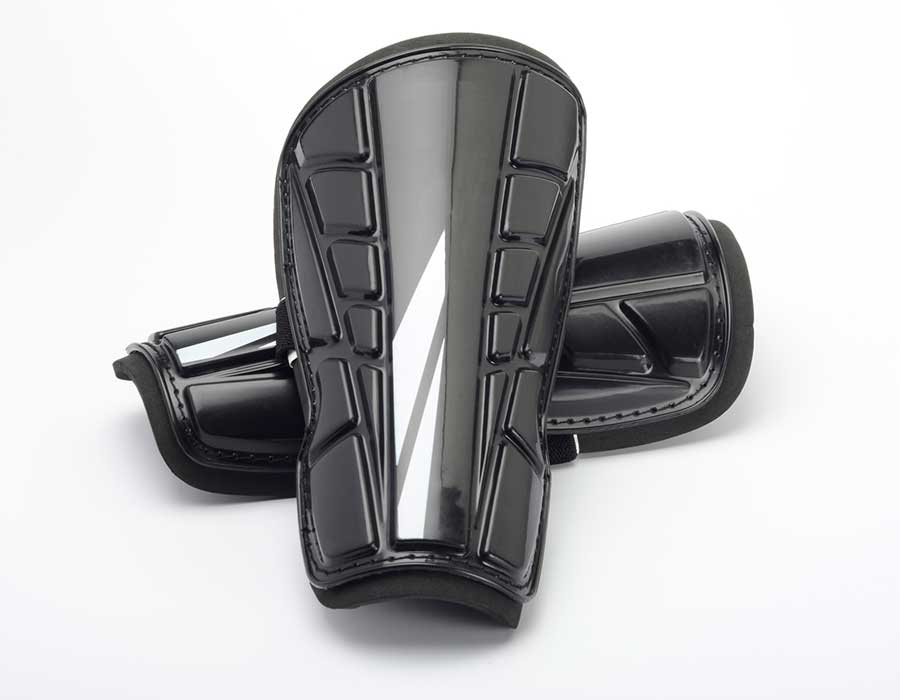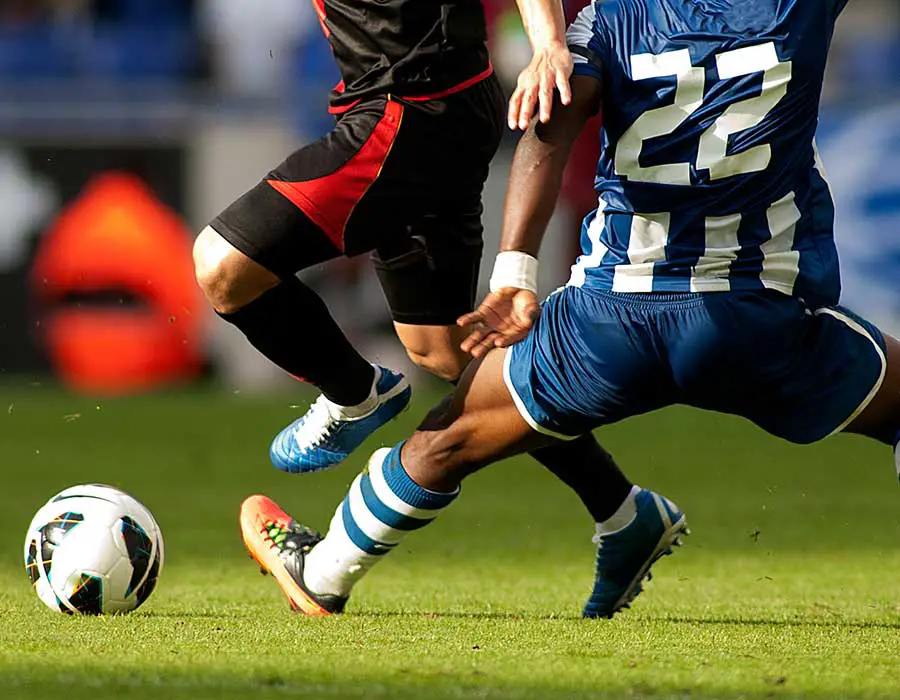Do Pro Soccer Players Wear Shin Guards?
Soccer is known as ‘the beautiful sport’, but it can also be tough. If you have ever played a soccer game, you will know that not so beautiful things can happen on the field.
For example, getting kicked on your shins. That is a regular occurrence in soccer but an unpleasant one. With soccer being the sport in which a ball is kicked with feet and legs, it’s normal for players to be accidentally kicked in their shins. It is why shin guards are so important. But do soccer players need to wear shin guards?

Yes, soccer players need to wear shin guards. If you play soccer in any organized league, you will need to wear shin guards. Even though you could play pickup games without them, any organized soccer means mandatory shin guard requirements are in place. And all of this is important to protect the players, the team, and the organizers of different competitions.
Even if you play soccer for your local school or in an amateur league, you still must wear shin guards. Here we will find why shin guards are mandatory for all soccer players, how and when were they introduced and what kind of different shin guards exist in modern soccer.
Why Do Soccer Players Need To Wear Shin Guards?
Soccer players need to wear shin guards to help prevent injuries. The most obvious reason is the safety of soccer players and their health. Shins are one of the most vulnerable parts of soccer players’ bodies. Shins are close to feet, which is why they are at the highest risk of getting kicked at any time during a game or even a practice session.
Anyone who has played soccer knows how painful it is to get kicked on an unprotected shin. Since that part of the bone is vulnerable, even the slightest hit or kick can make a soccer player go through pain. To help with that, soccer players wear shin guards.
They reduce the risk of injury, as the shin guard protects the bone from a painful impact and helps soccer players continue playing despite sometimes getting hit or kicked.
Do Pro Soccer Players Use Shin Guards?
But what about professional soccer players? Do they also need to wear shin guards at all times?
Yes, pro soccer players have to use shin guards. Soccer players are often famous and make a lot of money. However, while that can help them in many aspects of their lives, it doesn’t help them get around this rule. They cannot get away from wearing shin guards, despite their status. They are still subject to the same mandatory regulations as everybody else.
Soccer players could theoretically try to get on the field without their shin guards, but things are not that simple. A club would get fined by their respective organization if they were to allow such a thing to happen. And even then, referees also inspect the players before getting out on the field.
The regulations clearly state soccer players must wear shin guards. And why wouldn’t they wear them? They are helping the players against painful injuries, which can be easily avoided on most occasions.
Why Do Pro Soccer Players Use Small Shin Guards?
We have established that soccer players must wear shin guards. We also made it clear that shin guards are there to help prevent injuries. But despite all of that, many soccer players still wouldn’t want to have to wear shin guards.
That is because shin guards are not a natural piece of equipment to wear the way soccer boots or jerseys are. They can be uncomfortable at times and hinder movement.
That is why many soccer players wear small shin guards. That is especially the case with attacking players – they want to move as freely as possible, and smaller shin guards are helping them with that.
So instead of wearing bulky shin guards, which can be heavy and prevent them from getting hit in painful areas of their legs, many soccer players choose to wear small shin guards. They are lighter and less inconvenient, so soccer players find them better to use regularly. But does that mean soccer players are correct to use smaller shin guards?
Should Soccer Players Use Big Or Small Shin Guards?
Anyone starting to play soccer would need to choose what kind of shin guards they will wear. That means the question can become – should a soccer player wear big or small shin guards?
Simply put – there is no single or simple answer. The type of shin guards a soccer player will wear depends on the player himself. In most soccer competitions, there are no strict rules about the size of shin guards.
A soccer player can choose whether to wear small or big shin guards, and what material those shin guards will be made of. Therefore, the question changes into what that soccer player prefers more – having more freedom to control the ball or protecting himself from potential painful kicks to his legs?
A player could consider the position he plays at, whether he is a defender likely to put his body on the line to help the team or is he an attacker who wants to be as quick as possible. After all, this can be just a personal preference, considering most competitions have no strict rules about the size of shin guards.

When Were Shin Guards Introduced In Soccer?
Soccer is the most popular sport, but not all of the rules were original for this sport. Some of them were borrowed from other sports and adapted for soccer. Shin guards fall into this category.
Cricket first started using shin guards. This sport was where introducing shin guards to soccer came from. By the late 18th century, shin guards’ purpose had drifted from being used in battles and wars to entering the sporting arenas.
Cricket players used them first. The batsmen in cricket started using shin guards for two reasons – to protect their legs from getting hit by a small, hard ball; and to better cover the wicket with their protected legs to prevent the ball from hitting the stumps.
But these leg pads then found their way to soccer. Sam Weller Widdowson is the man who introduced shin guards to soccer back in 1874. The first national soccer association appeared in England in 1863, and the introduction of shin guards came pretty quickly afterwards.
Widdowson played soccer for Nottingham Forest, but also played cricket for Nottinghamshire. He was looking for a way to protect himself from getting painful kicks as frequently. Then, he started using his cricket pads and adjusting them for soccer, cutting them down and strapping them on his shins.
Other soccer players at first mocked his revolutionary move. However, the practicality of his invention made sure other soccer players soon started wearing shin guards as well. Since then, shin guards became a regular occurrence in soccer, but the world soccer’s governing body, FIFA, made them mandatory in professional soccer only in 1990.
What Material Are Shin Guards Made Of?
Shin guards can differ in their sizes, and soccer players from different positions on the field can choose to wear bigger or smaller ones. But soccer shin guards can also be made from various materials. All of those materials have their pros and cons, and it is again up to soccer players to decide what type of shin guards are best for them.
Following materials can be used for making shin guards:
- Fiberglass – these shin guards are lightweight and sturdy, but they can also be stiff next to a player’s leg.
- Polyurethane – shin guards made of this material are arguably the best ones because they offer almost complete protection from most impacts, but they can be heavy.
- Foam rubber – these shin guards are very light, but that makes them less solid compared to fiberglass, which means they offer less protection and more mobility.
- Plastic – is light and offers less protection than all the other types of shin guards.
- Metal – hardly anyone is wearing such shin guards because they are heavy and uncomfortable to wear, but they offer a high degree of protection for the player wearing them.
What Shin Guard Types Exist?
We have learned that shin guards for soccer players can differ in size and the types of materials they are made of. But they can also differ in what they are made for and what they can protect. There are three types of shin guards which are suitable for different needs:
Slip-in shin guards
These shin guards are the most usual ones. They are designed to slip inside a sock and stay there during the entire soccer match. Professional soccer players use them, because these shin guards offer enough protection on their shins, but are also lightweight and make it easier for them to move freely on the field. Because of this, they are usually more expensive than other models.
Ankle shin guards
Ankle shin guards are different from slip-in ones. They don’t protect only the shin but also extend from the knee to the ankle area as well. Such shin guards are highly durable and offer players a lot of protection. However, their drawbacks make them unsuitable for professional soccer players, restricting their movements on the field. Still, they are cheaper and are probably better for those just getting started in soccer.
Sock style guards
Sock style guards are the cheapest option among shin guards, but they were not designed for proper soccer matches. These guards offer the least protection and are for those who play soccer occasionally. Sock style guards are just socks with an inserted pad where the shin bone is.
Conclusion
Pro soccer players must wear shin guards during matches at all times. Shin guards became a thing almost 150 years ago to prevent players from getting injured by getting kicked on a painful shin bone, which is a usual occurrence in soccer. Shin guards can vary in sizes, materials, and styles, but every soccer player must wear them. It makes their lives easier and soccer more enjoyable!
